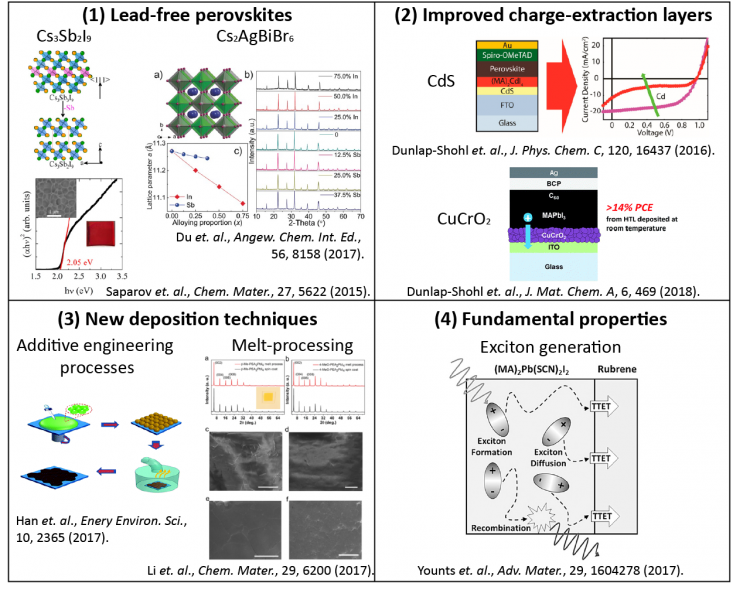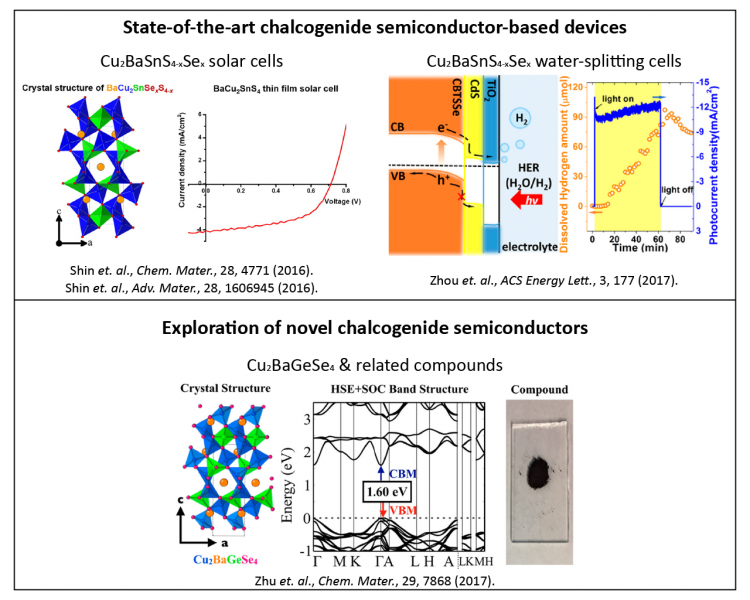Our group investigates two distinct classes of materials for energy applications: halide-based perovskites and multinary chalcogenides. Within each of these material families, we work to understand the physical, optical and electronic properties of the compounds and apply that understanding to the development of high performance optoelectronic devices such as solar cells, photoelectrochemical (water-splitting) cells and LEDs.
Halide-Based Perovskites
Materials adopting the perovskite crystal structure have emerged as a dominant force in the photovoltaics and energy materials research sphere within the last ten years. The intrinsic properties of these compounds make them very well suited for optoelectronic applications, including favorable optical/electronic properties (e.g., strong absorption, long carrier lifetimes and large carrier mobilities), flexible form factors, and facile solution- or vacuum-based film processing. However, the majority of the highest-performing compounds are based on lead (toxic) and are unstable under exposure to light, humidity and/or air. Each of these limitations present major hurdles to the deployment of perovskite-based devices on a commercial scale. Within the broader perovskite research landscape, our group has four main thrusts to move towards addressing some of these problems:
- Exploration of lead-reduced or lead-free optical absorbers;
- Development of improved charge extraction layers for optoelectronic devices;
- Advancement of new deposition and crystal-growth techniques; and
- Investigations of the fundamental structure-property relationships in organic-inorganic hybrids.

Multinary Chalcogenides
Chalcogenide semiconductors Cu(In,Ga)(S,Se)2 (CIGS), CdTe, and Cu2ZnSn(S,Se)4 (CZTS) have had much success as solar (photovoltaic or photoelectrochemical) absorbers in industry (CIGS and CdTe) and in research (CZTS). However, each of these materials is plagued by issues that may limit their widespread adoption as the solar absorber of the future: CIGS and CdTe are limited by the scarcity (In, Te) and toxicity (Cd) of their constituent elements, while CZTS is limited by poor defect properties. As solutions to these issues, our work focuses on the exploration of earth-abundant, non-toxic, and defect-tolerant semiconductors. Through this exploration of novel (or under-investigated) materials, we characterize the structural, optical, and electronic properties with the goal of including the materials as absorbers in renewable energy devices. Alongside the materials exploration, we work to establish sustainable solution- and vacuum-based film deposition methods for these chalcogenide semiconductors as well as research new device structures to improve device performance.
